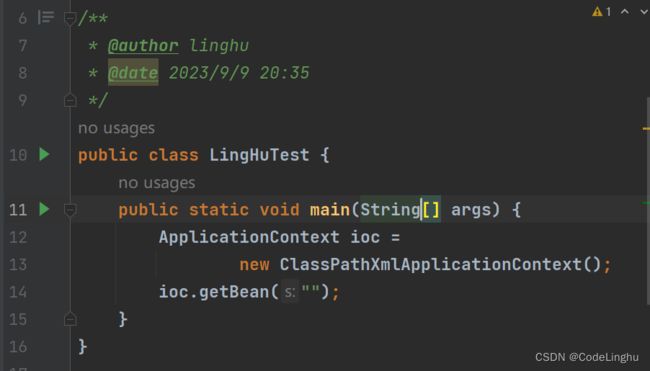手动开发-简单的Spring基于XML配置的程序--源码解析
手动开发-简单的Spring基于XML配置的程序
文章目录
- 手动开发-简单的Spring基于XML配置的程序
-
- 思路分析@
- 完整代码&:
本文带着大家写一个简单的Spring容器,通过读取beans.xml配置文件,获取第一个JavaBean:Monster的对象,并给对象赋值,放入到容器中,输出对象信息。
先回顾一下使用Spring时,我们是通过ClassPathXmlApplicationContext得到ioc容器,容器自动读取beans.xml配置文件,我们通过容器的getBean方法获取到对象,并输出该对象。
现在要做的就是:
- 自己实现一个ioc容器,前提是自己实现一个属于自己的
ClassPathXmlApplicationContext(); ClassPathXmlApplicationContext()中要提供一个getBean()方法。
思路分析@
这里其实重点分析ClassPathXmlApplicationContext()的具体实现过程:
- 定义一个
ioc的ConcurrentHashMap,存放对象名id和对象的映射。 - 创建一个构造器,将下面的操作都放在这个构造器里
- 使用
xml解析技术-dom4j技术,将beans.xml文件中的信息读取出来,并获取到节点信息的属性值 - 使用反射创建对象
- 将对象放入到
ioc中 - 提供一个
getBean方法
在通过 xml解析技术-dom4j技术,将beans.xml文件中的信息读取出来,并获取到节点信息的属性值时,需要先获取到beans.xml文件所在路径 。这里的路径是指 项目 编译后的文件所在路径,也就是target工作目录下的路径,我们的beans.xml文件是放在resource目录下的,经过编译后就会跑到target/classes目录下,所以在这里我们通过dom4j读取的目录应该是D:/Java/JavaProjects/spring-context-v1/target/classes/ ;完整的 文件工作路径应该是D:/Java/JavaProjects/spring-context-v1/target/classes/beans.xml ;
String path = this.getClass().getResource("/").getPath();
// System.out.println("path="+path);
SAXReader saxReader = new SAXReader();
Document document = saxReader.read(new File(path + iocBeanXmlFile));
在获取到document文档对象以后,我们就拿到了beans.xml里的所有内容,这个时候,我们获取到根节点,再通过根节点获取到bean标签的第一个bean对象,bean标签内的属性极其属性值都能获取到。通过bean标签的class属性可以获取到全类路径,拿到类路径就可以通过反射创建对象,这个对象的类型就是你类路径的对象。
SAXReader saxReader = new SAXReader();
Document document = saxReader.read(new File(path + iocBeanXmlFile));
Element rootElement = document.getRootElement();
Element bean = (Element) rootElement.elements("bean").get(0);
String id = bean.attributeValue("id");
String classFullPath = bean.attributeValue("class");
System.out.println("id="+id);
System.out.println("classFullPath="+classFullPath);
List<Element> property = bean.elements("property");
String monsterId = property.get(0).attributeValue("value");
String name = property.get(1).attributeValue("value");
System.out.println("monsterId="+monsterId);
System.out.println("name="+name);
通过反射创建的对象才能和Monster对象有相似的结构,我们可以把beans.xml中取出来的bean对象的属性值注入到我们反射创建的对象中,再把这个对象加入到ioc集合中。
Class<?> aClass = Class.forName(classFullPath);
Monster o = (Monster) aClass.newInstance();
o.setId(Integer.valueOf(monsterId));
o.setName(name);
ioc.put(id,o);
最后提供一个getBean方法,给出 monsterId的时候,能从ioc容器中找到对应映射的Monster对象。
public Object getBean(String id){
return ioc.get(id);
}
最后就实现了上图,我们只需要在xml文件中配置bean对象,再把xml文件的名字交给LingHuApplication容器进行初始化就可以得到一个ioc容器,ioc容器的本质就是一个ConcurrentHashMap。内部是通过dom4j去读取了bean对象的配置信息,通过这些信息如classFullPath反射创建对象,在往这个新对象中注入读取到bean对象的配置信息。这个新对象被我们放入到ConcurrentHashMap中了,我们通过getBean(String monsterId)方法去遍历ConcurrentHashMap找到新对象。
做这些事情的意义就在于,我们将配置工作和业务工作进行了分离,繁琐的对象管理工作一律通过配置文件来完成,降低了代码的耦合性,剥离了业务代码。所以Spring的容器思想的本质就是:ConcurrentHashMap+反射创建对象。
完整代码&:
LingHuApplication.java:
package com.linghu.spring.linghuapplication;
import com.linghu.spring.bean.Monster;
import org.dom4j.Document;
import org.dom4j.DocumentException;
import org.dom4j.Element;
import org.dom4j.io.SAXReader;
import org.springframework.context.annotation.ComponentScan;
import java.io.File;
import java.net.MalformedURLException;
import java.util.List;
import java.util.concurrent.ConcurrentHashMap;
/**
* @author
* @version 1.0
* * 1. 这个程序用于实现Spring的一个简单容器机制
* * 2. 后面我们还会详细的实现
* * 3. 这里我们实现如何将beans.xml文件进行解析,并生成对象,放入容器中
* * 4. 提供一个方法 getBean(id) 返回对应的对象
* * 5. 这里就是一个开胃小点心, 理解Spring容器的机制
*/
public class LingHuApplication {
private ConcurrentHashMap<String, Object> ioc =
new ConcurrentHashMap<>();
public LingHuApplication(String iocBeanXmlFile) throws MalformedURLException, DocumentException, ClassNotFoundException, InstantiationException, IllegalAccessException {
String path = this.getClass().getResource("/").getPath();
// System.out.println("path="+path);
//得到一个解析器
SAXReader saxReader = new SAXReader();
//老师的代码技巧->debug 看看document对象的属性
//分析了document对象的底层结构
Document document = saxReader.read(new File(path+iocBeanXmlFile));
//1. 得到rootElement, 你是OOP
Element rootElement = document.getRootElement();
//2. 得到第一个bean-monster01
Element bean = (Element) rootElement.elements("bean").get(0);
//获取到第一个bean-monster01的相关属性
String id = bean.attributeValue("id");
String classFullPath = bean.attributeValue("class");
List<Element> property = bean.elements("property");
System.out.println("id="+id);
System.out.println("classFullPath="+classFullPath);
//获取bean对象中的property属性值-id和name
String name = property.get(1).attributeValue("value");
String monsterId = property.get(0).attributeValue("value");
System.out.println("name="+name);
System.out.println("id="+monsterId);
//使用反射创建对象
Class<?> aClass = Class.forName(classFullPath);
//o对象就是monster对象
Monster o = (Monster) aClass.newInstance();
// System.out.println("o="+o);
o.setId(Integer.valueOf(monsterId));
o.setName(name);
//将创建好的对象放入到ioc对象中
ioc.put(id,o);
}
//提供一个getBean(id)返回对应的bean对象
public Object getBean(String id){
return ioc.get(id);
}
}
Gitee:《手动开发-简单的Spring基于XML配置的程序》


